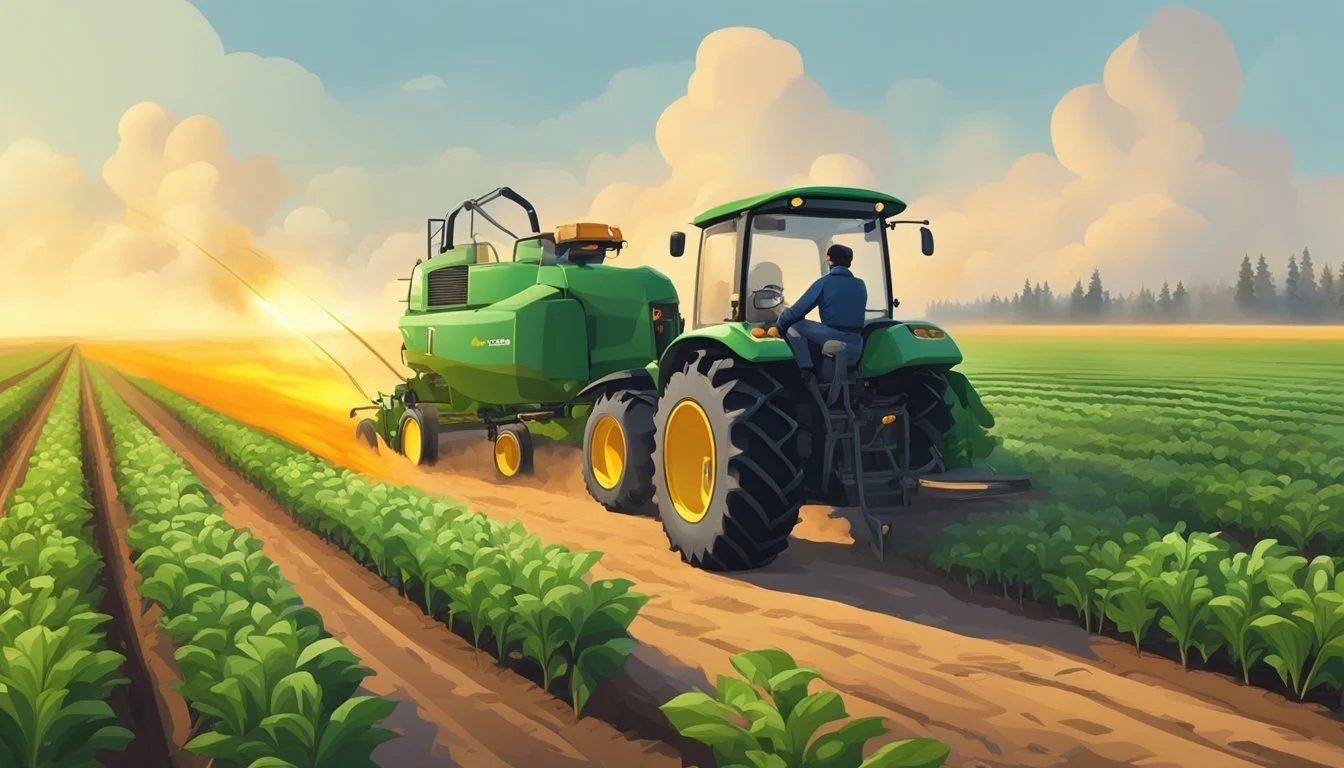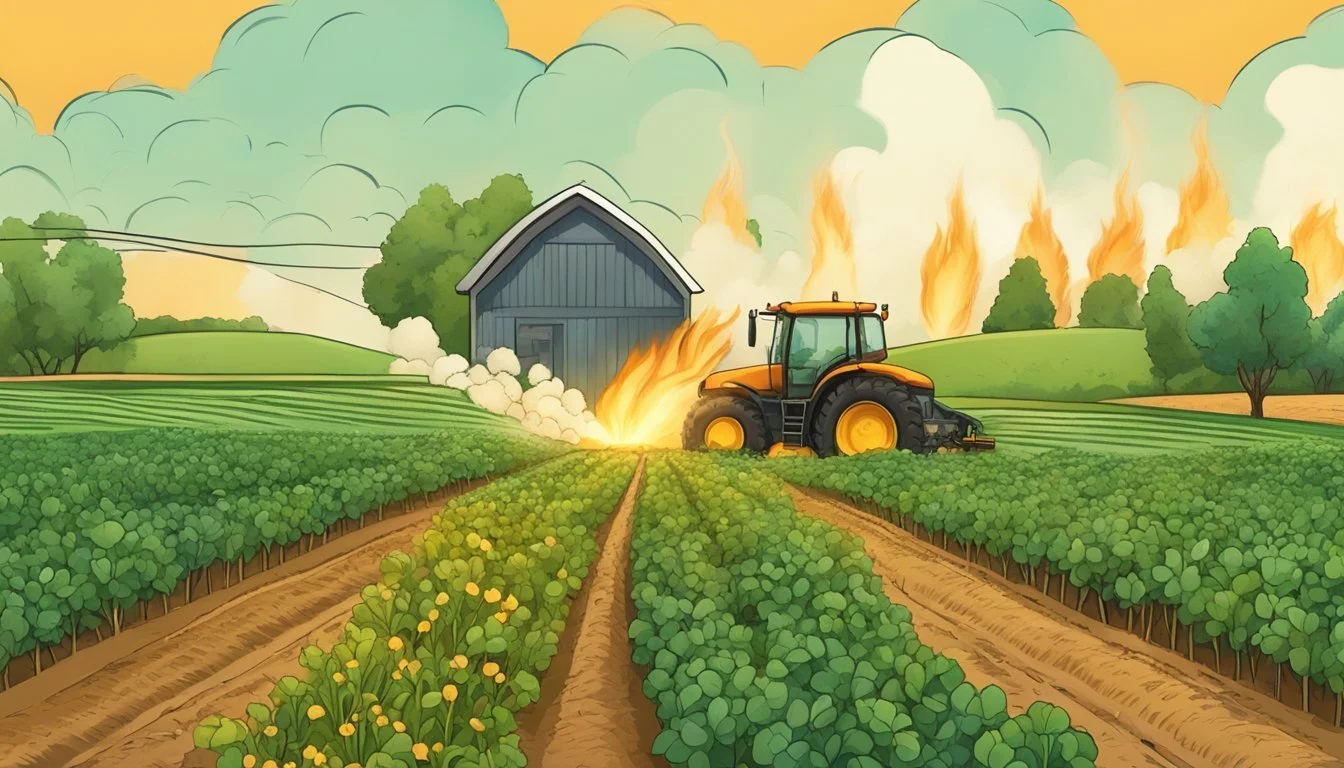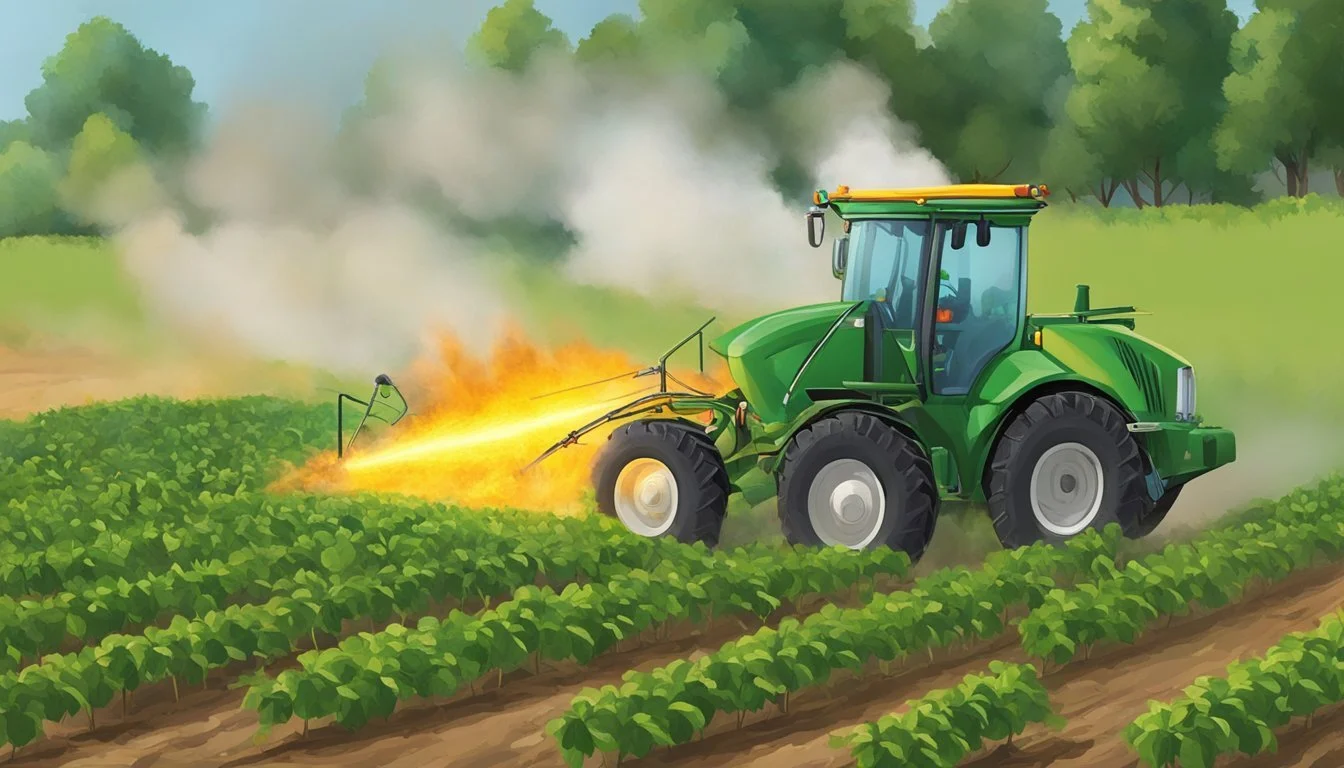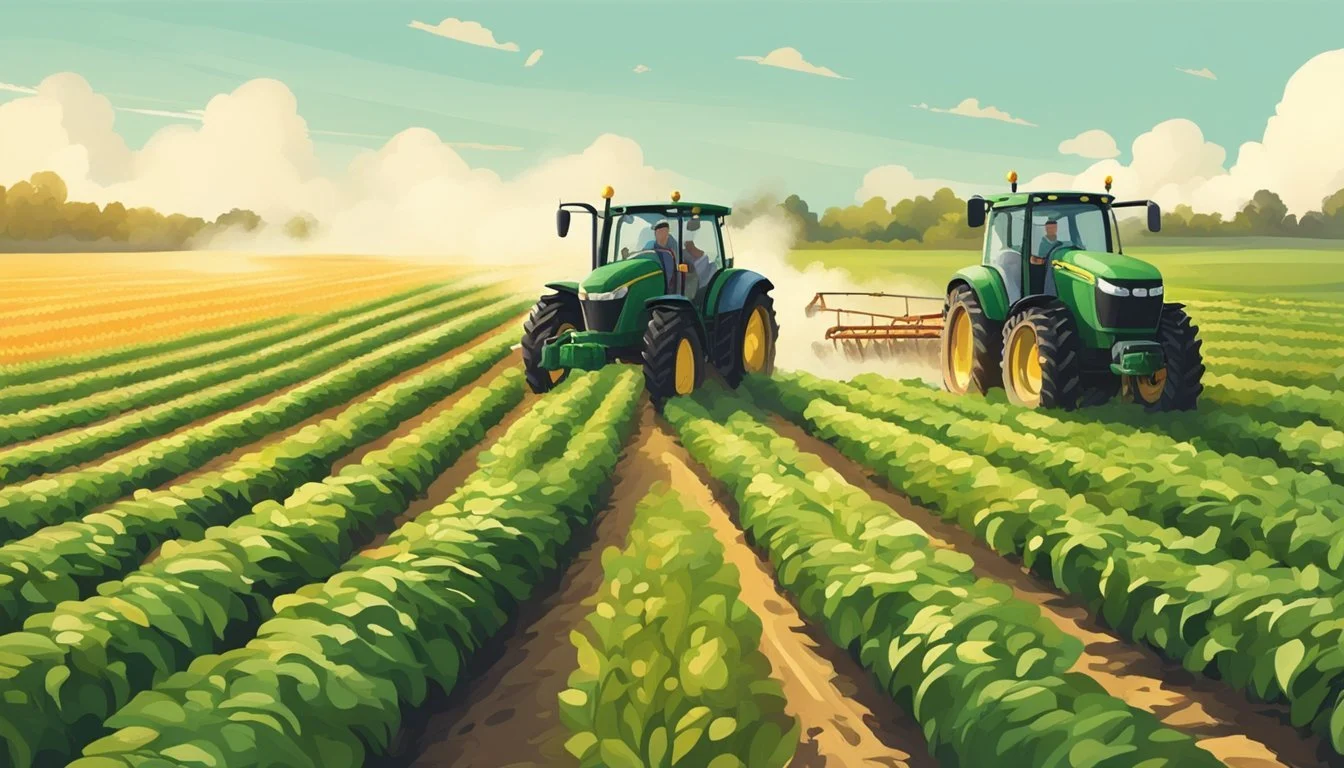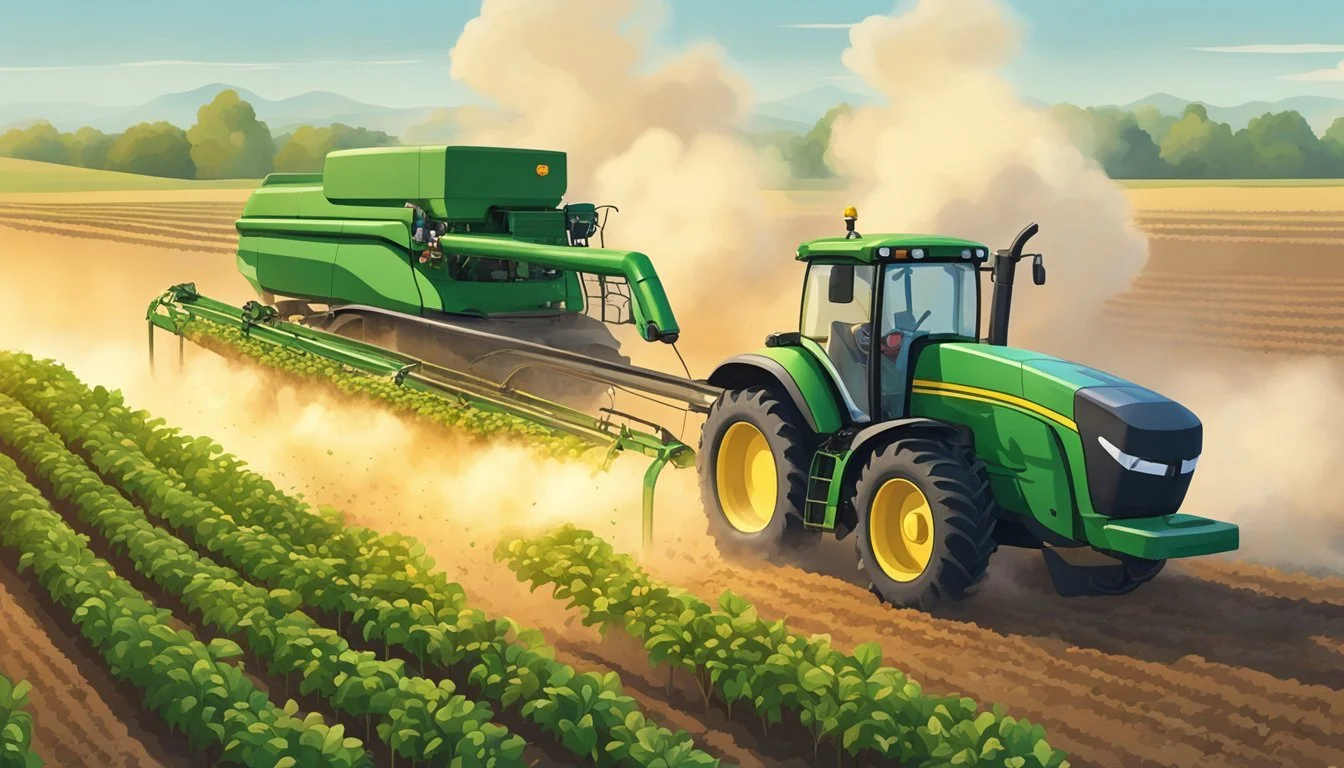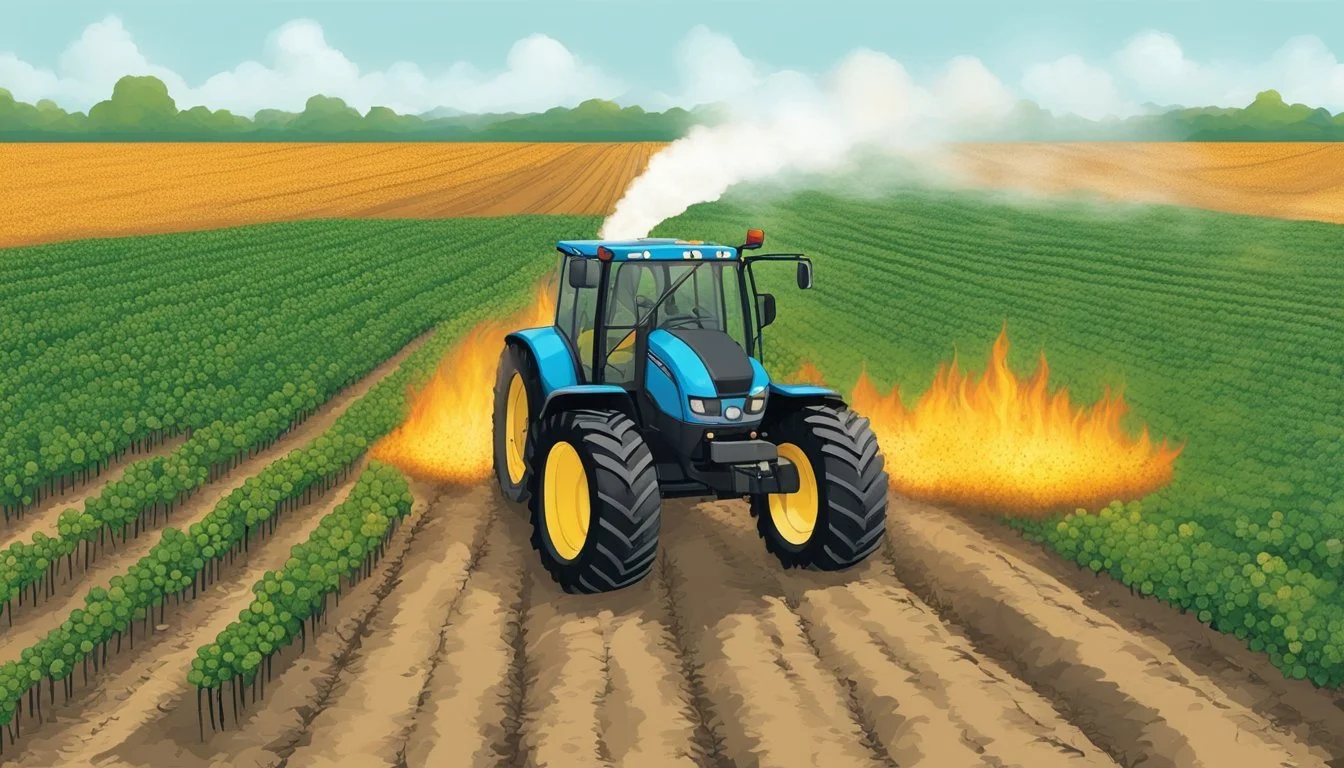Organic Pest Control and Weed Management
Enhancing Crop Health with a Flame Defoliator
Organic farming practices prioritize the use of natural processes and materials to enhance soil fertility and pest control. In the realm of such practices, organic pest control and weed management are critical components for maintaining crop health and ensuring high yields. Approaches to managing weeds and pests organically are numerous, with the aim of reducing reliance on synthetic herbicides and pesticides which can have negative environmental impacts. Crop flame defoliators emerge as an innovative tool in this sphere, utilizing the precise application of heat to control weed populations without the use of harmful chemicals.
The crop flame defoliator operates by directing flames towards unwanted vegetation, thereby raising the plant's cell temperature to the point of rupture, causing the weed to perish while minimizing damage to the crops. This method offers a viable alternative to traditional mechanical cultivation or hand weeding, especially in conditions where the soil is too moist or rocky for conventional implements. The benefits of using a crop flame defoliator in an organic farming setup are substantial, ranging from reduced labor costs to a decrease in the environmental impact typically associated with weed management.
Moreover, by employing flame as a management tool, farmers can potentially lower the risk of disrupting the soil structure or harming beneficial organisms present in the ecosystem. This addition to the organic farmer's arsenal complements other strategies such as crop rotation, enhancing crop competition, and cultural controls, all aimed at creating a more sustainable and productive agricultural system. The integration of crop flame defoliators thus reflects the evolving nature of organic farming, as it incorporates innovative methods to address age-old challenges of pest and weed management.
Understanding Organic Farming
Organic farming is driven by a set of well-defined principles and system-based approaches, with a sharp focus on natural inputs and ecological balance.
Principles of Organic Agriculture
Organic agriculture is founded on certain core principles to ensure sustainability and ecological balance. It emphasizes soil health as the foundation for healthy plants and encompasses strategies such as:
Soil Fertility: Maintaining soil health through natural inputs like compost and green manure, instead of synthetic fertilizers.
Biodiversity: Promoting diverse species of plants and animals to create a balanced ecosystem.
Resource Conservation: Efficient use of resources to minimize the ecological footprint of farming practices.
Natural Pest Management: Employing methods like introducing beneficial predators, using trap crops, and applying organic herbicides such as clove oil to manage pests without synthetic chemicals.
Through adherence to these principles, organic growers aim to produce crops that are healthy for consumers and the environment.
Organic Farming Systems
An organic farming system integrates cultural, biological, and mechanical practices that foster cycling of resources, promote ecological balance, and conserve biodiversity. Key components include:
Organic Pest Control: Utilizing practices that naturally reduce pest populations and maintain crop health without synthetic pesticides.
Crop Rotation: Changing crops in a sequence to disrupt pest cycles, improve soil health, and reduce weeds.
Organic Cropping Systems: Designing planting schemes that maximize the beneficial interactions among crops, pests, and natural predators.
Mechanical Weed Management: Using tools like a crop flame defoliator to manage weeds without synthetic herbicides.
Organic Herbicides: In instances where additional weed control is necessary, organic herbicides based on natural substances, such as clove oil, are used.
Overall, organic farming systems are designed to work with nature, rather than against it, which requires a deep understanding of ecological processes and the management of a farm as an integrated organism.
Overview of Weed Management
Effective weed management is crucial for a healthy crop yield. Understanding the biology of weeds and implementing integrated strategies are key components to controlling weed proliferation in agroecosystems.
Weed Biology and Ecology
Weed biology and ecology lay the groundwork for effective weed management practices. Weeds are plants that grow where they are not wanted, often competing with crops for resources. The life cycle of a weed includes seed germination, seedling emergence, growth, and reproduction. Understanding these phases is crucial for targeting weed control measures effectively. Weed seedbanks in the soil store the dormant potential of future weed flushes. Management must therefore aim to minimize weed seed germination and deplete the seedbank.
Herbicide-resistant weeds have emerged as a pivotal challenge, with certain species evolving resistance to commonly used chemicals. This adaptation pushes farmers to explore and employ various other control methods beyond chemical weed control, leading to more comprehensive and sustainable approaches to weed suppression.
Integrated Weed Management
Integrated Weed Management (IWM) involves a combination of methods, which can include cultural, chemical, mechanical, and biological strategies.
Cultural: These strategies enhance crop competition and reduce weed establishment. Tactics such as crop rotation and cover cropping can suppress weed growth.
Chemical: Herbicides are used with caution, targeting specific weed species and life stages while considering the potential for developing resistance.
Mechanical: Tillage and cultivation are physical means of disrupting weed emergence and growth.
Biological: Leveraging natural predators or competitors to manage weed population.
A successful IWM plan tailors these strategies to the crop and its specific weed pressure, seeking to intervene at critical points in the weed's life cycle. This approach also adapts to changes in weed biology, monitoring its response to management practices over time.
The principle of IWM is to use all available tools in a way that minimizes the reliance on any single method, particularly chemical methods, in an effort to delay or prevent the development of herbicide-resistant weeds.
Benefits of Crop Flame Defoliators
Crop flame defoliators offer an organic approach to weed management by utilizing intense heat to target problematic weed growth. This method presents a viable option that avoids chemical herbicides, focusing on efficiency and environmental integration.
Heat Application in Weed Control
Flame weeding, or flame cultivation, employs heat as its primary weapon against unwanted vegetation. The technique involves propelling heat, usually derived from propane combustion, directly onto the weeds. Heat tolerance varies among different plant species, with most undesirable weeds being less resistant to high temperatures compared to cultivated crops. This difference is exploited by passing a flame over the field, delivering combustion temperatures that quickly denature membrane proteins and lead to cell membrane rupture without harming the crops due to their comparative heat avoidance capabilities.
Mechanism of Action: When exposed to the high heat, the cell walls and membranes of the weeds expand and burst, causing irrevocable damage.
Required Propane Levels: Typically, 10 gallons of propane per acre are recommended to achieve effective weed control.
Efficacy Against Broadleaf Weeds and Grasses
Propane flaming is especially effective against both broadleaf weeds and grasses, as these types of weeds generally have less robust structures compared to cultivated plants. The efficacy of flame weeding can be noted in the quick response of these plants to the heat, where the high temperatures lead to immediate dehydration and death of the targeted weeds.
Broadleaf Weeds: Particularly susceptible due to their wide, thin leaves.
Grasses: Despite having a narrow leaf area, the sudden heat shock is sufficient to disrupt growth.
Propane flaming offers a precision that mechanical cultivation may not, as it can target weeds in between crop rows without disturbing the soil. This technique can also be beneficial when soil conditions are too moist or rocky for traditional mechanical methods. Flame defoliators provide an organic solution with fewer labor costs and minimal soil disruption while achieving effective weed management.
Ecological and Agricultural Impacts
The use of a crop flame defoliator in organic pest control and weed management entails significant effects on soil health and structure, as well as crop yield and quality, while also offering considerable environmental benefits.
Soil Health and Structure
Flame defoliation affects the soil by reducing weed competition, which can indirectly enhance soil structure. The targeted application of heat preserves soil integrity by minimizing disturbances, unlike mechanical weeding methods that may disrupt the soil surface and lead to soil erosion. Moisture retention is commonly better in areas with improved soil structure, which is crucial for the early growth of crops like corn and soybeans.
Impact on Soil Structure:
Reduces the need for tillage
Preserves soil aggregates
Minimizes the risk of soil compaction
Crop Yield and Quality
The use of crop flame defoliation can promote higher yield and improve crop quality by efficiently removing weeds without the use of chemical herbicides. This method is particularly advantageous during the early stages of crop growth, where competition for resources is critical. Implementing flame defoliation as part of a crop rotation strategy can lead to enhanced soil fertility, ultimately improving the performance of food crops such as corn and soybeans.
Crop Yield Factors:
Reduction in weed competition
Preservation of beneficial organisms
Improved nutrient uptake by crops
Environmental Benefits
Flame defoliation promotes an agroecological approach to farming, which favors environmental conservation. By reducing reliance on synthetic chemicals, it diminishes the risk of pollution and promotes biodiversity. The method encourages the use of cover crops to protect the soil, further mitigating soil erosion and enhancing the habitat for beneficial insects and organisms.
Key Environmental Advantages:
Decreased chemical runoff
Conservation of wildlife habitats
Support for agricultural sustainability
Applied conscientiously, crop flame defoliation provides a holistic method for combating pests and managing weeds that is in harmony with the ecological dynamics of farmland ecosystems.
Weed Control Techniques
Effective weed management in organic systems focuses on preventing weed establishment and controlling growth through a combination of mechanical and cultural methods. The goal is to minimize the impact of weeds on crop production while adhering to organic farming principles.
Mechanical and Cultural Weed Control
Mechanical and cultural weed control strategies are the backbone of organic weed management. These methods disrupt the growth and spread of weeds without the use of synthetic herbicides.
Tillage: Tillage is a traditional method used to manage weeds by burying weed seeds and disrupting established weed growth. However, excessive tillage can lead to soil erosion and loss of soil organic matter.
Cultivation: Carefully timed and executed, cultivation with tools such as a cultivator or a rotary hoe can effectively control weeds between rows and around crops. The timing of cultivation is critical to avoid damage to crop roots and to ensure that weeds are destroyed while they are still small.
Hand Weeding: Although labor-intensive, hand weeding is precise and allows for the removal of weeds without damaging the crops. It is particularly useful for controlling weeds within the crop row.
Machinery: Farmers use a range of machinery like harrows and cultivators, adjusted to the specific needs of the crop and field conditions. Machinery is chosen to effectively remove weeds while minimizing disruption to the soil and crops.
Residues and Stale Seedbed: Utilizing crop residues or creating a stale seedbed can suppress weed growth. Crop residues can act as a mulch that reduces light penetration and weed seed germination. A stale seedbed technique involves allowing weeds to germinate before planting the crop, then destroying them, reducing weed pressure during crop emergence.
Organic Approaches to Weed Suppression
Organic systems require a more diversified approach to weed control by enhancing the competitive ability of the crop and deploying the right treatments at optimal times.
Crop Rotation: Rotating crops can disrupt the life cycles of weeds and reduce weed seed banks in the soil. Inclusion of certain crops like field corn can suppress weed growth by outcompeting them for resources.
Planting Dates: Adjusting planting dates can allow the crop to get ahead of the weed growth, taking advantage of critical periods for weed emergence.
Cultural Management: Cultural management practices such as increasing crop density or altering row spacing can reduce weed pressure by outcompeting weeds for light and nutrients.
Organic weed management strategies in crops like vegetables often lead to higher production costs due to the need for additional labor or machinery use. However, the long-term benefits of these practices include healthier soil, reduced pest pressure, and the maintenance of biodiversity in farm ecosystems. Timing and knowledge of weed and crop lifecycles are essential to the successful implementation of these techniques.
Weather and Timing Considerations
To achieve the best results in organic pest control and weed management using crop flame defoliators, one must pay careful attention to the nuances of weather patterns and the intricacies of correct timing. Both weather and timing are intrinsic to the effectiveness of flaming treatments and must be aligned properly to avoid crop injury and ensure rapid and effective weed management.
Optimizing Flaming Treatments
The efficacy of a flame defoliator is largely dependent on calm weather conditions. Wind can significantly diminish the precision of the flame, leading to uneven weed exposure and potential crop injury. Farmers should monitor weather forecasts closely and only apply flame treatments during periods of low wind to ensure a controlled and even application of heat.
For timing, there is an optimal moment during weed growth—usually at the cotyledon stage—when weeds are most vulnerable to heat treatments. Flaming should be done when weeds are small and have not yet established a strong root system. Early intervention prevents weeds from competing with crops for essential nutrients and resources.
Ideal Conditions for Flaming Treatments:
Wind: Less than 10 mph
Weed Growth Stage: Cotyledon to early leaf stage
Time of Day: Morning or late afternoon (reduced wind, moderate temperatures)
Adjusting to Climate Variability
Climate variability is a pivotal factor that can alter the schedule and frequency of flame defoliator use. As temperatures and precipitation patterns shift, so too do the growth cycles of both crops and weeds. Farmers must remain flexible and adjust their weed management strategies accordingly.
Heat plays a crucial role in the successful use of crop flame defoliators. Flaming on a hot day enhances the effect of the flame, resulting in rapid weed cell rupture and dehydration. However, high temperatures also raise the risk of crop injury. Flame treatments should be conducted during cooler parts of the day to protect crops while still effectively controlling weed populations.
Strategies for Adjusting to Climate Variability:
Monitoring: Keep track of short-term weather changes and long-term climate trends.
Scheduling: Plan treatments for the coolest part of the day to mitigate crop stress while capitalizing on heat for weed control.
Crop Selection: Choose crops that are more heat-tolerant or have a robust structure to minimize injury.
Addressing Limitations and Challenges
In employing a crop flame defoliator for weed management within organic farming, one must consider potential challenges. These include ensuring the safety of crops and addressing the potential for weed resistance.
Preventing Damage to Organic Crops
The primary concern with flame weeding is the potential for damaging the organic crops it aims to protect. Flame defoliators must be used with precision to target weeds without harming the main crop. Techniques such as shielding can protect crops by directing the heat solely at the weeds. Additionally, timing is crucial; the process should be conducted when crops are less susceptible to heat damage, perhaps at certain growth stages where they are more robust.
Weed Resistance and Management
Weed resistance to flame weeding is not a widely reported issue, but a monocultural approach to weed management could theoretically lead to it. Organic weed management should integrate numerous strategies including cultural and genetic methods, in a parallel approach. For instance:
Cultural: Implementing crop rotation to reduce weed buildup and improve soil health.
Genetic: Developing crop varieties that outcompete weeds or are less affected by heat applications.
By employing diverse strategies, the chances of developing weed resistance are minimized, ensuring the long-term health and productivity of organic systems.
Complementary Strategies and Alternatives
In the pursuit of organic pest control and weed management, employing a comprehensive approach bolsters the effectiveness of using a crop flame defoliator. Smart integration of cultural management practices can enhance the crop's competitive edge against pests and weeds.
Using Cover Crops and Mulches
Cover Crops play a crucial role in organic farming not only as a physical barrier against weeds but also in enhancing soil health. The deliberate planting of cover crops, such as rye or clover, competes effectively with weeds by limiting light and space, integral resources that weeds require for germination and growth. Strategies involve:
Time of planting: Establish cover crops during periods when weeds are known to proliferate.
Species selection: Select cover crops that are fast-growing and dense to outcompete weeds for resources.
Additionally, Mulches, including organic materials such as straw or plastic mulches, serve as a direct suppression method, impeding weed emergence through the creation of a physical barrier. They also:
Retain soil moisture
Improve soil structure
Regulate soil temperature that may affect weed biology
Integrating Livestock and Sanitation
Integrating Livestock, particularly in pasture-based systems, can be an effective weed management tool. Livestock grazing may reduce the weed seed bank through consumption and trampling. Other benefits include:
Pest Control: Livestock can disrupt pest life cycles.
Soil Aeration: Hoof activity can aerate the soil, promoting root growth for the main crop.
Sanitation measures are vital in preventing the spread of weeds and pests from infected areas to clean areas. Proper cleaning of farm equipment and removal of infested plant material diminishes the risk of spreading weed seeds and pests. It involves:
Regular washing and brushing of equipment and tools
Managing plant residues to prevent them from serving as pest habitats
Special Considerations for Specific Crops
Crop flame defoliators offer a unique solution in organic pest control and weed management. However, the application and efficacy can vary significantly depending on the crop in question. Careful consideration and understanding of the crop's growth stages and sensitivity to heat are vital for successful weed control.
Managing Weeds in Corn and Soybeans
In corn and soybean production systems, timing is critical. Weed flaming is most effective when it's conducted pre-emergence of the crop or when the weeds are in the juvenile stage, as they are more susceptible to heat at this time. However, one must ensure that the crops themselves are at a growth stage resilient enough to withstand indirect heat.
Corn:
Pre-emergence flaming can be done before crop sprouts.
Post-emergence flaming requires a high level of precision, avoiding heat contact with corn.
Soybeans:
Similar to corn, pre-emergence flaming is beneficial.
For post-emergence, ensure that the soybean plants are in the "crook" stage, where they can tolerate brief heat exposure.
Weed Control in Vegetable Production
Vegetable production systems require more nuanced approaches to flaming given the diversity of species and their varying tolerances to heat. The effect of flaming as it pertains to vegetables is greatly dependent on the type of vegetables grown.
Root Vegetables (e.g., carrots, beets):
Flame before seeding or right after the vegetable seeds have been planted.
Provides a window of opportunity for the crop to emerge in a weed-free environment.
Leafy Vegetables (e.g., lettuce, spinach):
Care must be taken to not expose these to flaming after emergence due to their sensitivity.
Flaming can be conducted between the rows as a method of inter-row weed control.
In each case, organic producers must monitor environmental conditions such as moisture levels and wind speed to optimize the effectiveness of weed control while minimizing any potential crop damage.
Case Studies and Real-World Applications
This section delves into specific examples of organic growers who have successfully implemented flame defoliators in their pest and weed management practices, as well as lessons learned from experiences where weed management did not go as planned.
Success Stories from Organic Growers
Organic producers have often had to innovate with their strategies to manage weeds, striving to maintain soil health and ecosystem balance. Flame weeding, a method that involves using controlled flames to eliminate weeds, has been adopted by many organic farms with a high success rate. For example, a certain organic vegetable farm was able to reduce its weed population significantly by incorporating flame weeding into its crop rotation system. The farm reported not only fewer weeds but also less crop damage compared to mechanical cultivation methods. Flame weeding effectively removed dense weed residues in between crop rows while preserving the integrity of the soil.
Learning from Weed Management Failures
Not all weed management strategies yield positive results. Some organic growers have shared their challenges when misapplication of flame weeding led to insufficient control of weed populations or, worse, damage to the crops themselves. These negative outcomes often stemmed from improper timing or intensity of flame application. By analyzing these failures, however, growers can better understand the importance of following precise guidelines for flame defoliator use — such as optimal weather conditions and the weeds' growth stages. Careful adjustments in these areas lead to improved overall health of the crops and a more sustainable organic weed management regimen.
Conclusion
Crop flame defoliators represent an innovative tool in the arsenal of organic farming techniques, offering a viable and eco-friendly alternative for managing weeds. They provide farmers with a method to reduce weed populations and enhance crop yields without resorting to chemical herbicides. This aligns well with organic farming principles which emphasize environmental sustainability and the avoidance of synthetic substances.
Effective use of flame defoliators requires adherence to best practice guidelines. For example, it is critical that they are used on a level soil surface to ensure uniform weed control. Studies have demonstrated that, when correctly applied, flame weeding can be more effective than mechanical cultivation, especially in crops like popcorn where maintaining weed-free conditions is paramount.
Farmers are increasingly adopting flame weeding due to its multiple advantages, which include:
Reduced dependence on chemical weed management
Decreased risk of herbicide resistance
Enhanced soil health by avoiding the mechanical disruption
Potential for selective weeding which preserves desired flora
In conclusion, a crop flame defoliator offers an efficient method to manage weeds and pests in organic farming systems, balancing the demands for productivity and sustainability. As organic farming continues to advance, such tools take on an essential role, ensuring farmers can maintain ecological balance while meeting the challenges of modern agriculture.

